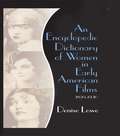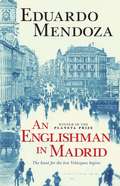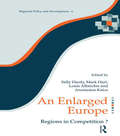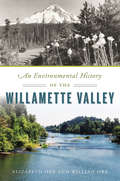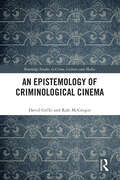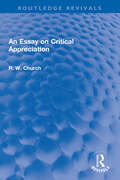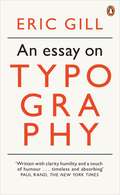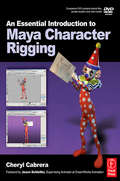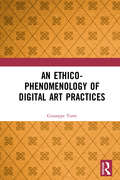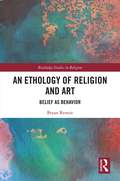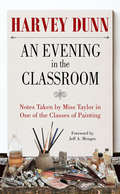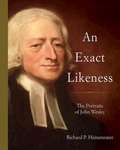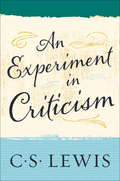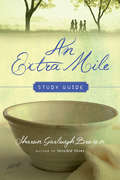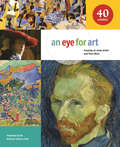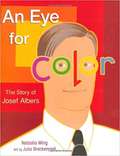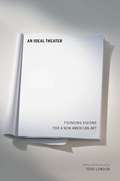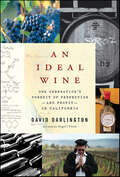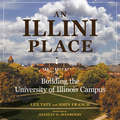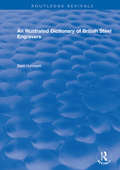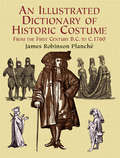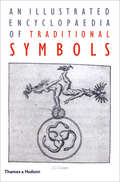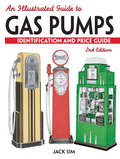- Table View
- List View
An Encyclopedic Dictionary of Women in Early American Films: 1895-1930
by Denise LoweExamine women&’s contributions to film-in front of the camera and behind it! An Encyclopedic Dictionary of Women in Early American Films: 1895-1930 is an A-to-Z reference guide (illustrated with over 150 hard-to-find photographs!) that dispels the myth that men dominated the film industry during its formative years. Denise Lowe, author of Women and American Television: An Encyclopedia, presents a rich collection that profiles many of the women who were crucial to the development of cinema as an industry-and as an art form. Whether working behind the scenes as producers or publicists, behind the cameras as writers, directors, or editors, or in front of the lens as flappers, vamps, or serial queens, hundreds of women made profound and lasting contributions to the evolution of the motion picture production. An Encyclopedic Dictionary of Women in Early American Films: 1895-1930 gives you immediate access to the histories of many of the women who pioneered the early days of cinema-on screen and off. The book chronicles the well-known figures of the era, such as Alice Guy, Mary Pickford, and Francis Marion but gives equal billing to those who worked in anonymity as the industry moved from the silent era into the age of sound. Their individual stories of professional success and failure, artistic struggle and strife, and personal triumph and tragedy fill in the plot points missing from the complete saga of Hollywood&’s beginnings. Pioneers of the motion picture business found in An Encyclopedic Dictionary of Women in Early American Films include: Dorothy Arnzer, the first woman to join the Directors Guild of America and the only female director to make a successful transition from silent films to sound Jane Murfin, playwright and screenwriter who became supervisor of motion pictures at RKO Studios Gene Gauntier, the actress and scenarist whose adaptation of Ben Hur for the Kalem Film Company led to a landmark copyright infringement case Theda Bara, whose on-screen popularity virtually built Fox Studios before typecasting and overexposure destroyed her career Madame Sul-Te-Wan, née Nellie Conley, the first African-American actor or actress to sign a film contract and be a featured performer Dorothy Davenport, who parlayed the publicity surrounding her actor-husband&’s drug-related death into a career as a producer of social reform melodramas Lois Weber, a street-corner evangelist who became one of the best-known and highest-paid directors in Hollywood Lina Basquette, the "Screen Tragedy Girl" who married and divorced studio mogul Sam Warner, led The Hollywood Aristocrats Orchestra, claimed to have been a spy for the American Office of Strategic Services during World War II, and became a renowned dog expert in her later years and many more! An Encyclopedic Dictionary of Women in Early American Films: 1895-1930 also includes comprehensive appendices of the WAMPAS Baby Stars, the silent stars remembered in the Graumann Chinese Theater Forecourt of the Stars and those immortalized on the Hollywood Walk of Stars. The book is invaluable as a resource for researchers, librarians, academics working in film, popular culture, and women&’s history, and to anyone interested either professionally or casually in the early days of Hollywood and the motion picture industry.
An Englishman in Madrid
by Eduardo MendozaAnthony Whitelands, an English art historian, is invited to Madrid to value an aristocrat's collection. At a welcome lunch he encounters José Antonio Primo de Rivera, founder and leader of the Falange, a nationalist party whose antics are bringing the country ever closer to civil war. The paintings turn out to be worthless, but before Whitelands can leave for London the duque's daughter Paquita reveals a secret and genuine treasure, held for years in the cellars of her ancestral home. Afraid that the duque will cash in his wealth to finance the Falange, the Spanish authorities resolve to keep a close eye on the Englishman, who is also being watched by his own embassy. As Whitelands - ever the fool for a pretty face - vies with Primo de Rivera for Paquita's affections, he learns of a final interested party: Madrid is crawling with Soviet spies, and Moscow will stop at nothing to secure the hidden prize.
An Englishman in Madrid
by Eduardo MendozaAnthony Whitelands, an English art historian, is invited to Madrid to value an aristocrat's collection. At a welcome lunch he encounters José Antonio Primo de Rivera, founder and leader of the Falange, a nationalist party whose antics are bringing the country ever closer to civil war. The paintings turn out to be worthless, but before Whitelands can leave for London the duque's daughter Paquita reveals a secret and genuine treasure, held for years in the cellars of her ancestral home. Afraid that the duque will cash in his wealth to finance the Falange, the Spanish authorities resolve to keep a close eye on the Englishman, who is also being watched by his own embassy. As Whitelands - ever the fool for a pretty face - vies with Primo de Rivera for Paquita's affections, he learns of a final interested party: Madrid is crawling with Soviet spies, and Moscow will stop at nothing to secure the hidden prize.
An Enlarged Europe: Regions in Competition? (Regions and Cities #No. 6)
by Mark Hart Sally Hardy Louis Albrechts Anastasios KatosThe political and economic geography of Europe is changing - the European Community is expanding its boundaries towards EFTA and is resuming a closer association with Central and Eastern European regions engaged in radical restructuring. As EC integration accelerates there is the prospect of intensified inter-regional competition. This book, divided into five parts, examines in detail the changes and the challenge for policy makers. The introduction draws out the central themes of the book, addressing EC regional performance and future indicators, the enlargement and changing map of Europe and the implications for the EC of Eastern European changes. The second part deals with EC issues, particularly focusing on the economic and spatial impact of European integration. Part 3 addresses Eastern European issues, and Part 4 covers the Peripheral Regions. The final part is devoted to a policy debate, concluding with a policy agenda for the forthcoming decade.
An Environmental History of the Willamette Valley (Natural History)
by Elizabeth Orr William OrrWestern Oregon's Willamette Basin, once a vast wilderness, became a thriving community almost overnight. When Oregon territory was opened for homesteading in the early 1800s, most of the intrepid pioneers settled in the valley, spurring rapid changes in the landscape. Heralded as fertile with a mild climate and an abundance of natural resources, the valley enticed farmers, miners and loggers, who were quickly followed by the construction of rail lines and roads. Dams were built to harness the once free-flowing Willamette River and provide power to the growing population. As cities rose, people like Portland architect Edward Bennett and conservationist governor Tom McCall worked to contain urban sprawl. Authors Elizabeth and William Orr bring to life the changes that sculpted Oregon's beloved Willamette Valley.
An Epistemology of Criminological Cinema (Routledge Studies in Crime, Culture and Media)
by Rafe McGregor David GrčkiStanding at the intersection of criminology and philosophy, this book demonstrates the ways in which mythic movies and television series can provide an understanding of actual crimes and social harms.Taking three social problems as its subjects – capitalist political economy, structural injustice, and racism – the book explores the ways in which David Fincher’s Fight Club (1999), HBO’s Game of Thrones (2011–2019), and Jordan Peele’s Us (2019) offer solutions by reconceiving justice in terms of personal and collective transformation, utopian thinking, and the relationship between racism and elitism, respectively. In doing so, the authors set out a theory of understanding the world based on cinematic and televisual works of art and conclude with a template that establishes a methodology for future use.An Epistemology of Criminological Cinema is authoritative and accessible, ideal reading for undergraduate and postgraduate students, criminologists, philosophers, and film, television, and literary critics with an interest in social justice and social harm.
An Essay on Critical Appreciation (Routledge Revivals)
by Ralph W. Church dec'dFirst published in 1938, An Essay on Critical Appreciation aims to provide a language suited for the explication on beauty. This explication is not based merely on emotion but is motivated by contemplation and discrimination. By virtue of being rendered in a discourse, an appreciation can claim to be critical or discriminating and ‘beauty’ can be said to have characteristics. The search of such a language takes the author through the contemplation on the meaning of ‘beauty’, entertaining contrary views, and reaching at an understanding of the aesthetic situation. This book will be of interest to students of English literature, philosophy and art.
An Essay on Typography (Penguin Modern Classics)
by Eric GillEric Gill's opinionated manifesto on typography argues that 'a good piece of lettering is as beautiful a thing to see as any sculpture or painted picture'. This essay explores the place of typography in culture and is also a moral treatise celebrating the role of craftsmanship in an industrial age. Gill, a sculptor, engraver, printmaker and creator of many classic typefaces that can be seen around us today, fused art, history and polemic in a visionary work which has been hugely influential on modern graphic design.'Written with clarity, humility and a touch of humour . . . timeless and absorbing' Paul Rand, The New York Times'His lettering was clear, confident and hugely influential on the development of modern type design. The world has now caught up with Gill' GuardianHow do we see the world around us? This is one of a number of pivotal works by creative thinkers like John Berger and Susan Sontag whose writings on art, design and the media have changed our vision for ever.
An Essential Introduction to Maya Character Rigging with DVD
by Cheryl CabreraDiscover the concepts and techniques required to rig engaging CG character models with Maya in this unique book and DVD package. The stunning color images show just what you can achieve, and the detailed step-by-step tutorials show exactly how to achieve them. Every technique and tip is backed up with practical tutorials, using the models, student
An Ethico-Phenomenology of Digital Art Practices
by Giuseppe TorreDigital art practitioners work under the constant threat of a medium – the digital – that objectifies the self and depersonalises artistic identities. If digital technology is a pharmakon in that it can be either cure or poison, with regard to digital art practices the digital may have in fact worked as a placebo that has allowed us to push back the date in which the crisis between digital and art will be given serious thought. This book is hence concerned with an analysis of such a relationship and proposes their rethinking in terms of an ethico-phenomenological practice informed by an in-depth understanding of the digital medium. Giuseppe Torre engages with underground cultures such as Free and Libre Open Source Software (FLOSS) and its ties with art discourse. The discussion is informed by various philosophical discourses and media theories, with a focus on how such ideas connect back to the existing literature in performance studies. Replete with examples of artwork and practices, this book will be of great interest to students and scholars of theatre and performance studies, art and technology.
An Ethology of Religion and Art: Belief as Behavior (Routledge Studies in Religion)
by Bryan RennieDrawing from sources including the ethology of art and the cognitive science of religion this book proposes an improved understanding of both art and religion as behaviors developed in the process of human evolution. Looking at both art and religion as closely related, but not identical, behaviors a more coherent definition of religion can be formed that avoids pitfalls such as the Eurocentric characterization of religion as belief or the dismissal of the category as nothing more than false belief or the product of scholarly invention. The book integrates highly relevant insights from the ethology and anthropology of art, particularly the identification of "the special" by Ellen Dissanayake and art as agency by Alfred Gell, with insights from, among others, Ann Taves, who similarly identified "specialness" as characteristic of religion. It integrates these insights into a useful and accurate understanding and explanation of the relationship of art and religion and of religion as a human behavior. This in turn is used to suggest how art can contribute to the development and maintenance of religions. The innovative combination of art, science, and religion in this book makes it a vital resource for scholars of Religion and the Arts, Aesthetics, Religious Studies, Religion and Science and Religious Anthropology.
An Evening in the Classroom: Notes Taken by Miss Taylor in One of the Classes of Painting
by Harvey Dunn"Dunn, in his teaching, was more concerned with the essential spirit of work than with technical procedures. He never taught what kind of brushes or what kind of paint to use. It was merely whether the result had anything in common with the excitement of human existence." — Dean Cornwell, "the Dean of Illustrators" Illustrator and painter Harvey Dunn was deeply influenced by Howard Pyle and the teaching he received while at his school. Pyle's Brandywine students became some of the most important and well-regarded artists of the twentieth century, including N. C. Wyeth, Frank Schoonover, Violet Oakley, and Jessie Willcox Smith. All studied alongside Dunn, and many of them would go on to teach. Dunn embraced Pyle's approach as an instructor and went on to influence the next generation of artists. During the course of an evening in 1934, while Dunn was teaching at Grand Central School of the Arts, one Miss Taylor, a witness to the class, recorded his comments and criticisms. These notes later surfaced in a slim, limited-edition volume. Enhanced by Dunn's striking woodcut images, the book provides a flavorful re-creation of the atmosphere in his classroom. An Evening in the Classroom is the best-preserved record of Dunn's critiques, and this handsome hardcover book will instruct and inspire artists, teachers and students, and art historians.
An Exact Likeness: The Portraits of John Wesley
by Richard P. HeitzenraterFaces are more than a montage of organs that see, breathe, speak, hear, eat, sing, smell, and yell. As Josephine Tey points out in her mystery novel, The Daughter of Time, the slant of an eyebrow, the set of a mouth, the look of the eye, the firmness of a chin, often can provide evidence of character that is as telling as a report card or a police blotter. Those features depicted on portraits of individuals can be equally telling of the person’s inner nature or perhaps of what the artist thinks (or wants the viewer to think) about the person being portrayed. Sometimes a portrait might be even more useful than a biography.While examining these portraits, the author considers three questions: what was Wesley’s attitude toward the portrait (if any), how did the public respond to these portrayals, and what was the artist attempting to convey? This book focuses on the main portraits and their derivatives, looking at them within the three main categories that developed over the years: Oxford don, Methodist preacher, and notable person. Although these types seemed to arise in chronological order, there is some overlap between categories, especially toward the end of Wesley’s life and beyond.
An Experiment in Criticism
by C. S. LewisWhy do we read literature and how do we judge it? C. S. Lewis's classic An Experiment in Criticism springs from the conviction that literature exists for the joy of the reader and that books should be judged by the kind of reading they invite. He argues that "good reading," like moral action or religious experience, involves surrender to the work in hand and a process of entering fully into the opinions of others: "in reading great literature I become a thousand men and yet remain myself." Crucial to his notion of judging literature is a commitment to laying aside expectations and values extraneous to the work, in order to approach it with an open mind. Amid the complex welter of current critical theories, C. S. Lewis's wisdom is valuably down-to-earth, refreshing and stimulating in the questions it raises about the experience of reading.
An Extra Mile Study Guide: A Story Of Embracing God's Call (Sensible Shoes Series)
by Sharon Garlough BrownWhat next steps is God calling you to take? Join the characters of An Extra Mile, the final book in the Sensible Shoes series, as they journey through the seasons of Lent and Easter. In this eight-week study guide you'll dive deeper into key spiritual practices from the book, using daily Scripture readings and reflection questions designed to help you be attentive to the invitations of the Holy Spirit. Each week concludes with discussion questions and suggested practices for groups to do together. This guide offers the perfect tools for individuals and groups to explore and apply the spiritual formation themes of An Extra Mile along with Mara, Hannah, Charissa, and Becca.
An Eye for Art: Focusing on Great Artists and Their Work
by National Gallery of ArtLavishly illustrated with hundreds of full-color images, this family-oriented art resource introduces children to more than 50 great artists and their work, with corresponding activities and explorations that inspire artistic development, focused looking, and creative writing. This treasure trove of artwork from the National Gallery of Art includes, among others, works by Raphael, Rembrandt, Georgia O'Keeffe, Henri Matisse, Chuck Close, Jacob Lawrence, Pablo Picasso, and Alexander Calder, representing a wide range of artistic styles and techniques. Written by museum educators with decades of hands-on experience in both art-making activities and making art relatable to children, the activities include sculpting a clay figure inspired by Edgar Degas; drawing an object from touch alone, inspired by Joan Miro's experience as an art student; painting a double-sided portrait with one side reflecting physical traits and the other side personality traits, inspired by Leonardo da Vinci's Ginevra de' Benci; and creating a story based on a Mary Cassatt painting. Educators, homeschoolers, and families alike will find their creativity sparked by this art extravaganza.
An Eye for Color: The Story of Josef Albers
by Natasha Wing Julia Breckenreid<p>As a child, Josef Albers loved to watch his handyman father paint houses.When Josef grew up and became an artist, he reduced each image to its simplest shapes, breaking it down into blocks of color. <p>He made an incredible discovery: he could alter the entire mood of a painting just by changing the way he combined the colors! Josef spent his entire life studying color, and what he found revolutionized the way people look at art.</p>
An Eye for Hitchcock: Revised Edition
by Murray PomeranceFilm scholar Murray Pomerance presents a series of fascinating and groundbreaking meditations on six films directed by the legendary Alfred Hitchcock, a master of the cinema. Two of the films, North by Northwest and Vertigo, are extraordinarily famous and have been seen––and misunderstood––countless times. Two others, Marnie and Torn Curtain, have been mostly disregarded by viewers and critics or considered to be colossal mistakes, while the remaining two, Spellbound and I Confess, have received almost no critical attention at all. Here in a twentieth-anniversary edition, with a new preface, An Eye for Hitchcock—the first volume of the Hitchcock Quartet (which includes A Dream of Hitchcock, A Voyage with Hitchcock, and A Silence from Hitchcock)—examines these movies under a bold new light. Pomerance takes us deep into the structure of Hitchcock's vision and his screen architecture, revealing key elements that have never been written about before. Pomerance also clearly reveals the link between Hitchcock's work and a wide range of thinkers and artists in other fields, thereby offering viewers of Hitchcock's films the rare opportunity to see them afresh and with new excitement.
An Ideal Theater
by Todd LondonAn Ideal Theater is a wide-ranging, inspiring documentary history of the American theatre movement as told by the visionaries who goaded it into being. This anthology collects over forty essays, manifestos, letters and speeches that are each introduced and placed in historical context by the noted writer and arts commentator, Todd London, who spent nearly a decade assembling this collection. This celebration of the artists who came before is an exhilarating look backward, as well as toward the future, and includes contributions from:Jane Addams William Ball Julian Beck Herbert Blau Angus Bowmer Bernard Bragg Maurice Browne Robert Brustein Alison Carey Joseph Chaikin Harold Clurman Dudley Cocke Alice Lewisohn Crowley Gordon Davidson R. G. Davis Doris Derby W. E. B. Du Bois Zelda Fichandler Hallie Flanagan Eva Le Gallienne Robert E. Gard Susan Glaspell André Gregory Tyrone Guthrie John Houseman Jules Irving Margo Jones Frederick H. Koch Lawrence Langner W. McNeil Lowry Charles Ludlam Judith Malina Theodore Mann Gilbert Moses Michaela O'Harra John O'Neal Joseph Papp Robert Porterfield José Quintero Bill Rauch Bernard Sahlins Richard Schechner Peter Schumann Maurice Schwartz Gary Sinise Ellen Stewart Lee Strasberg Luis Miguel Valdez Nina Vance Douglas Turner WardAs well as the founding visions of theatres from across the country:The Actors Studio The Actor's Workshop Alley Theatre American Conservatory Theater American Repetory Theater Arena Stage Barter Theatre Bread and Puppet Theater The Carolina Playmakers The Chicago Little Theater Circle in the Square Theatre The Civic Repertory Theatre Cornerstone Theater Company The Federal Theatre Project Ford Foundation Program in Humanities and the Arts The Free Southern Theater The Group Theatre The Hull-House Dramatic Association KRIGWA Players The Living Theatre La MaMa Experimental Theatre Club The Mark Taper Forum The Mercury Theatre Minnesota Theater Company (Guthrie Theater) The National Theatre of the Deaf The Negro Ensemble Company The Negro Theatre Project, Federal Theatre Project The Neighborhood Playhouse New Dramatists The New York Shakespeare Festival The Open Theater Oregon Shakespeare Festival The Performance Group The Provincetown Players The Repertory Theater of Lincoln Center The Ridiculous Theatrical Company Roadside Theater The San Francisco Mime Troupe The Second City Steppenwolf Theatre Company El Teatro Campesino Theater '47 The Theatre Guild The Theatre of the Living Arts The Washington Square Players The Wisconsin Idea Theater Yale Repertory Theatre The Yiddish Art TheatreTodd London is in his 18th season as artistic director of New Dramatists, the nation's oldest center for the creative and professional development of American playwrights. In 2009 Todd became the first recipient of Theatre Communications Group's (TCG) Visionary Leadership Award for "an individual who has gone above and beyond the call of duty to advance the theater field as a whole, nationally and/or internationally." He's the author of The Importance of Staying Earnest: Writings from Inside the American Theatre, 1988-2013 (NoPassport Press), Outrageous Fortune: The Life and Times of the New American Play (with Ben Pesner, Theatre Development Fund), The Artistic Home (TCG), and The World's Room, a novel (Steerforth Press), among others. His column, "A Lover's Guide to American Playwrights," tributes to contemporary
An Ideal Wine: One Generation's Pursuit of Perfection—and Profit—in California
by David DarlingtonFromDavid Darlington, author of the acclaimed Angels’ Visits (published inpaperback as Zin), comes an inside look at howa handful of visionary winemakers has transformed—and been transformed by—theCalifornia wine industry over the past four decades. In the tradition of TheWidow Clicquot and The Billionaire’s Vinegar,Darlington’s An Ideal Wine is afascinating, lively tale of vision and daring, of business and politics, ofnature and culture, and of the unlikely birth of a multi-billion dollarindustry.
An Illini Place: Building the University of Illinois Campus
by Incoronata Inserra John Franch Lex TateWhy does the University of Illinois campus at Urbana-Champaign look as it does today? Drawing on a wealth of research and featuring more than one hundred color photographs, An Illini Place provides an engrossing and beautiful answer to that question. Lex Tate and John Franch trace the story of the university's evolution through its buildings. Oral histories, official reports, dedication programs, and developmental plans both practical and quixotic inform the story. The authors also provide special chapters on campus icons and on the buildings, arenas and other spaces made possible by donors and friends of the university. Adding to the experience is a web companion that includes profiles of the planners, architects, and presidents instrumental in the campus's growth, plus an illustrated inventory of current and former campus plans and buildings.
An Illustrated Dictionary of British Steel Engravers (Routledge Revivals)
by Basil HunnisettFirst published in 1989, An Illustrated Dictionary of British Steel Engravers contains more than 600 entries and an extensive plate section, providing examples of work referenced in the text and adding a clear chronological dimension to the subject. The book makes use of an array of surviving accounts and correspondence of engravers and publishers and adopts a comprehensive and systematic approach to identifying different types and variants of steel engravings over time. Equipped with a detailed introduction to the history of steel engravings, An Illustrated Dictionary of British Steel Engravers will be of great use to those interested in illustration, graphic art, Victorian literature, and the history of printing.
An Illustrated Dictionary of Historic Costume (Dover Pictorial Archive Series)
by James R. PlancheThousands of terms associated with apparel worn in the principal countries of Europe appear in this extensive and convenient reference. The alphabetically arranged items of clothing span nearly 2,000 years of fashion history — from the onset of the Christian era in the first century to the beginning of the reign of George III, c. 1760.From abacot, hacketon, helm, jipocoat, and jump to xainture, ysgyn, zatayn, and zibelline, the sweeping scope of this volume encompasses a remarkable range of all-but-forgotten lore. Profusely illustrated with over 1,300 detailed line drawings, it offers a useful guide for fashion and cultural historians, writers, designers, movie and theatrical producers, and all others with an interest in the history of fashion.
An Illustrated Encyclopaedia of Traditional Symbols
by J. C. CooperIn nearly 1500 entries, many of them strikingly and often surprisingly illustrated, J. C. Cooper has documented the history and evolution of symbols from prehistory to our own day. With over 200 illustrations and lively, informative and often ironic texts, she discusses and explains an enormous variety of symbols extending from the Arctic to Dahomey, from the Iroquois to Oceana, and coming from systems as diverse as Tao, Christianity, Judaism, Buddhism, Islam, Tantra, the cult of Cybele and the Great Goddess, the Pre-Columbian religions of the Western Hemisphere and the Voodoo cults of Brazil and West Africa.
An Illustrated Guide To Gas Pumps: Identification And Price Guide
by Jack SimWith 2,000 gas pumps, including many never-before-seen illustrations and secondary market pricing, featured in a clear and concise format, there's no doubt why An Illustrated Guide to Gas Pumps, 2nd Edition is the top choice for anyone with an appreciation for petroliana. Listed alphabetically by manufacturer, this new edition covers 100 years of pumps through detailed listings including production information, company history and fun facts about pump operations. Ultimate online gas pump site - www.oldgas.com identifies no less than 100 restored stations and petroliana museums around the U.S. and abroad Features 1,500 color illustrations, including many never-before-seen images of pumps manufactured between 1885 and 1967
